 |
 |
 |
| |
Transgender Women (TGW) in HPTN 083: An Evaluation of Safety, Efficacy, and Gender Affirming Hormonal Therapy (GAHT) Interactions with Long-acting Cabotegravir (CAB-LA)
|
| |
| |
AIDS 2022
Beatriz Grinsztejn1, Brett Hanscom2, Zhe Wang2, Deborah Donnell2, Paul Richardson3, Philip Sullivan3, Susan Eshleman3, Andrea Jennings4, Kailazarid Gomez-
Feliciano4, Kritima Samitpol5, Emilia Jalil1, Nadir Cardozo6, Bernardo Maia7, Taimur Khan8, Yashna Singh9, Julie Franks10, Javier Valencia11, Christina Psaros12, Steven Safren13, Naiymah Sanchez4, Jonathan Lucas4, Cheryl Blanchette4, James Rooney14, Alex Rinehart5, Susan Ford15, Adeola Adeyeye16, Myron Cohen17, Marybeth McCauley4, Raphael J Landovitz18, Mark A Marzinke3
Instituto Nacional de Infectologia Evandro Chagas-Fiocruz, RJ/Brazil, 2Fred Hutchinson Cancer Center, Seattle/US, 3Johns Hopkins University, Baltimore/US, 4FHI 360, Durham, North Carolina/US, 5 Thai Red Cross AIDS Research Centre, Thailand, 6 Fundación Huésped CRS, Argentina, 7 Hospital Emílio Ribas, SP/Brazil, 8 Fenway Health CRS, Boston, US, 9 Groote Schuur HIV CRS, Cape Town/South Africa, 10 Harlem Prevention Center CRS, New York/US, 11Barranco CRS, Peru, 12Massachusetts General Hospital, Boston/US, 13Coral Gables, FL/US, 14Gilead Sciences, Foster City/US, 15ViiV Healthcare, Research Triangle, North Carolina/US, 16National Institutes of Health, Rockville, MD/US, 17University of North Carolina at Chapel Hill, Chapel Hill/US, 18Center for Clinical AIDS Research and Education, David Geffen School of Medicine, University of California, Los Angeles/US

Pre-specified subpopulations historically underrepresented in PrEP registrational trials, including TGW, were successfully enrolled and retained in the study, thereby fostering inclusion and equity in scientific development. As transgender women (TGW) remain a priority group for HIV prevention, we report participant characteristics, safety, prevention efficacy, and pharmacokinetics (PK) of CAB-LA in TGW during the blinded phase of HPTN 083.
Of 4,566 participants enrolled in HPTN 083, 570 (12.5%) were TGW by self-identification.
Participant characteristics, including gender affirming hormone therapy (GAHT) use, history of interpersonal violence, and HIV risk perception, were collected at baseline and throughout the study, and compared between TGW and cisgender MSM.
CAB PK was compared in a subset of TGW in the presence or absence of GAHT; in this analysis, 30 participants accessed GAHT, while 23 participants were not using GAHT. Study participants in this analysis received all CAB-LA injections on-time through week 53. CAB drug concentrations were comparable between the two groups, suggesting the lack of a GAHT effect on CAB PK (Figure 1).
Regardless of study arm, at baseline, TGW enrolled in the study experienced an increased frequency of sexual (56.7% vs. 45.4%), physical (30.2% vs. 19.2%), and emotional (47.4% vs. 36.4%) interpersonal violence when compared to MSM (Table 3).Further, when study participants were queried regarding their perceptions about HIV acquisition risk, self-perceived risk was lower for TGW as compared to MSM (44.4% vs. 32.5%).
CAB-LA was well tolerated in TGW; the frequency of grade 2+ AEs did not meaningfully differ between TGW receiving CAB-LA or TDF/FTC (92.5% vs. 88.8%).
HIV incidence among TGW during the blinded phase of the trial was 1.80% (TDF/FTC) and 0.54% (CAB-LA) (hazard ratio: 0.343, 95%, CI 0.08-1.56). Incidence of STIs among TGW were comparable between study arms (Table 4).
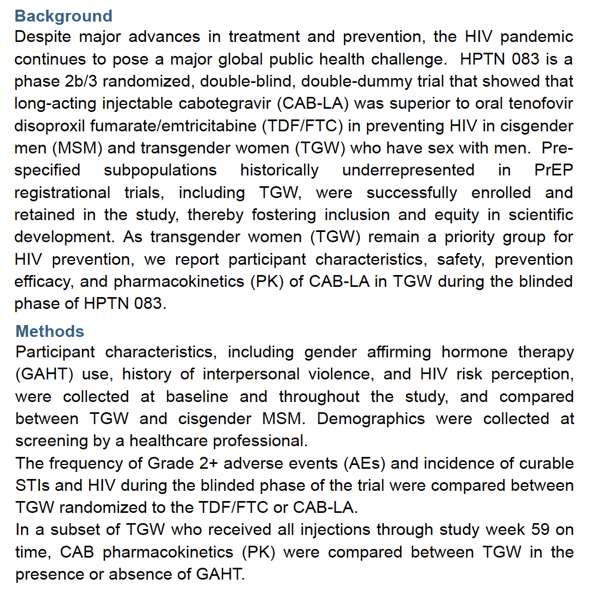
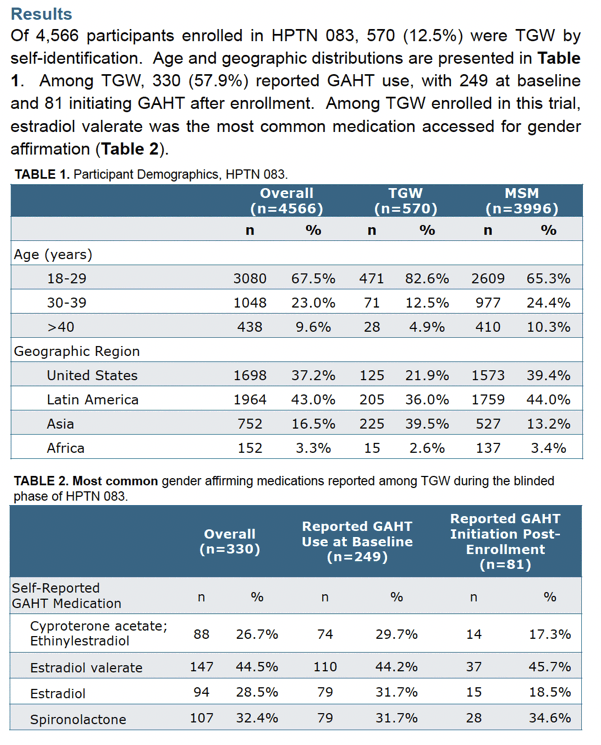
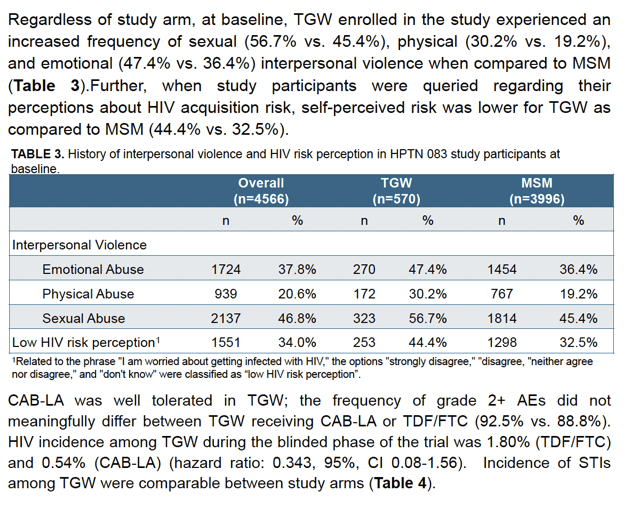
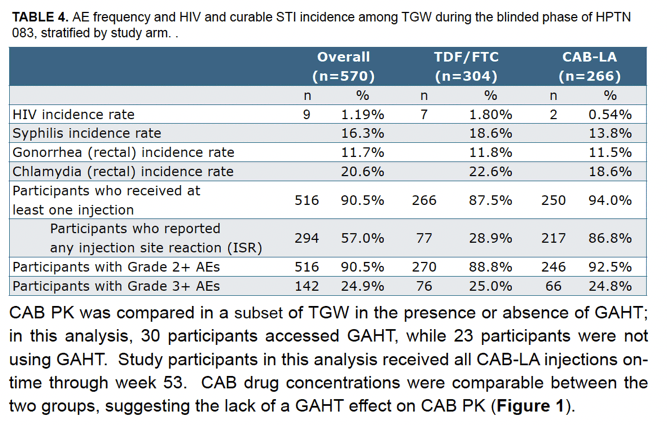
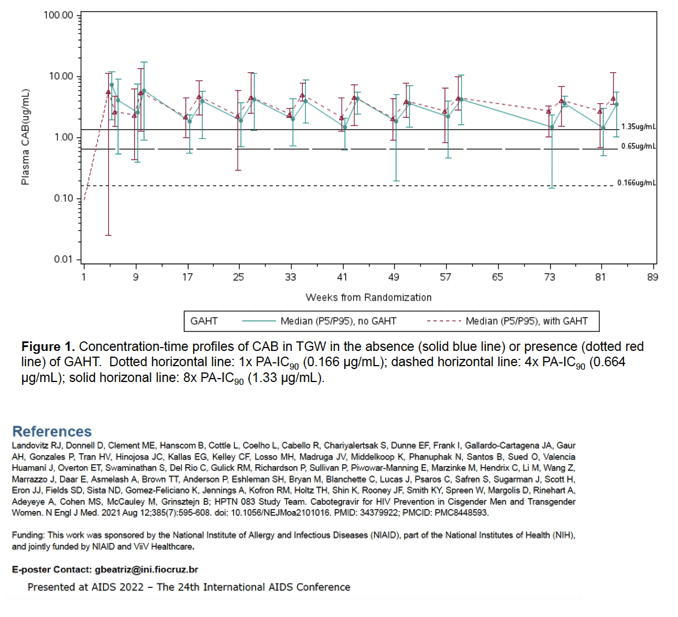
|
| |
|
 |
 |
|
|